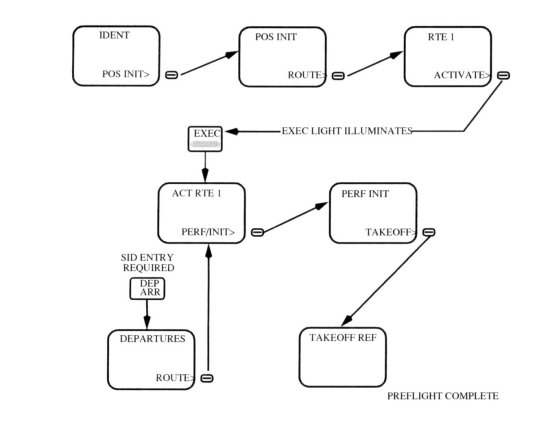Preflight - Introduction
FMC preflight is required before flight.
Completion of the FMC preflight requires data entry in all minimum required data locations. Additional entry of optional preflight data optimises FMC accuracy.
Preflight Page Sequence
The usual FMC power-up page is the Identification page. Preflight flow continues in this sequence:
- Identification (IDENT) page
- Position Initialisation (POS INIT) page
- ROUTE page
- DEPARTURES page (no automatic prompt)
- Performance Initialisation (PERF INIT) page
- Takeoff Reference (TAKEOFF REF) page
Some of these pages are also used in flight.
Minimum Preflight Sequence

During preflight, a prompt in the lower right directs the flight crew through the minimum requirements for preflight completion. Selecting the prompt key displays the next page in the flow. If a required entry is missing, a prompt on the Takeoff page leads the crew to the preflight page missing data.
When the TAKEOFF REF page is reached it confirms that all required preflight entries have been made by displaying PRE-FLT COMPLETE.
Airplane inertial position is necessary for FMC preflight and flight instrument operation.
A route must be entered and activated. The minimum route data is origin and destination airports, and a route leg. When ACTIVATE is selected on the route page the EXEC key illuminates. The EXEC key should then be pushed to complete the task of making the route active before continuing the sequence.
Performance data requires the airplane weight and cruise altitude.
PEGASUS/SPEED TAPE as installed
Takeoff data requires a flap setting.
Supplementary Pages
Supplementary pages are sometimes required, these pages have no prompts and interrupt the usual sequence. Discussions of each page include methods to display the page.
When the route includes SIDs and STARs, they can be entered using the DEPARTURES or ARRIVALS pages.
Route discontinuities are removed and the route is modified on the ROUTE and RTE LEGS pages. Speed/Altitude restrictions are entered and removed on the RTE LEGS page. The RTE LEGS page is described in the FMC Cruise section.
PEGASUS FMC
With the PEGASUS FMC installed, alternate airports are added on the ALTN page. The ALTN page is described in the FMC Descent and Approach section.
Waypoint, navaid, airport and runway data is referenced on the REF NAV DATA page. The REF NAV DATA page is described in the FMC Cruise section.
VNAV performance is improved if forecast winds and temperatures are entered during the preflight.
PEGASUS FMC
Wind and temperature data for specific waypoints is entered on the WIND page. The WIND page is described in the FMC Cruise section.
NON PEGASUS FMC
Wind and temperature data for the initial portion of the route is entered on the PERF INIT page. Forecast winds for other waypoints may be entered on the RTE DATA page to improve FMC performance predictions.
Preflight Pages - Part 1
The preflight pages are presented in the sequence used during a typical preflight.
CDU Operation - General Rules
To avoid errors, work in a slow deliberate manner while operating the CDU. Avoid pushing more than one key at a time. Avoid entering data in both CDUs at the same time. Do not push CDU keys when the system is going through a resynchronisation. Resynchronisations take about 15 seconds to complete. During this time one map and CDU shows a failed condition while the other CDU displays the RESYNCING OTHER FMC message.
When selecting a CDU page read the page title to ensure the correct page appears.
Check that the scratch pad line is blank before trying to enter data on the line. Use the CLR key as required to blank the scratch pad.
When entering data on the scratch pad line ensure that it is correct before continuing with the procedure.
Use care when pushing line select keys to ensure the correct key is being pushed.
Confirm that data displayed on the CDU is correct before pushing the EXEC key. If an error has been made, correct the erroneous data or push the ERASE line select key and then restart the procedure. Data cannot be entered on a blank line.
Messages that commonly indicate an error has been made are NOT IN DATA BASE, INVALID ENTRY and INVALID DELETE.
Pegasus | 11.40.1 | INIT/REF INDEX![]()